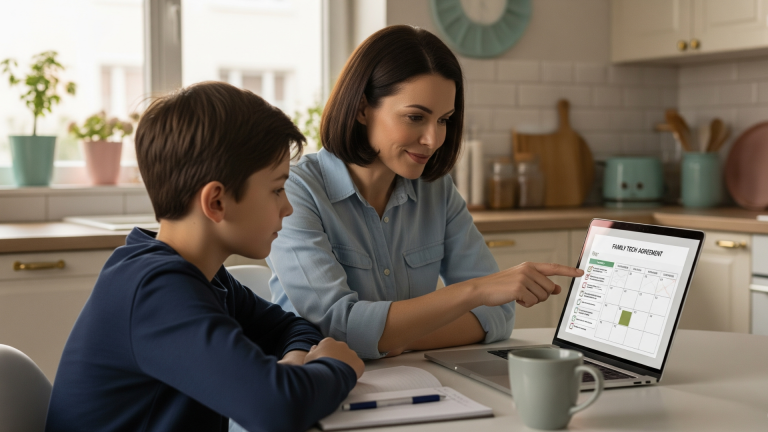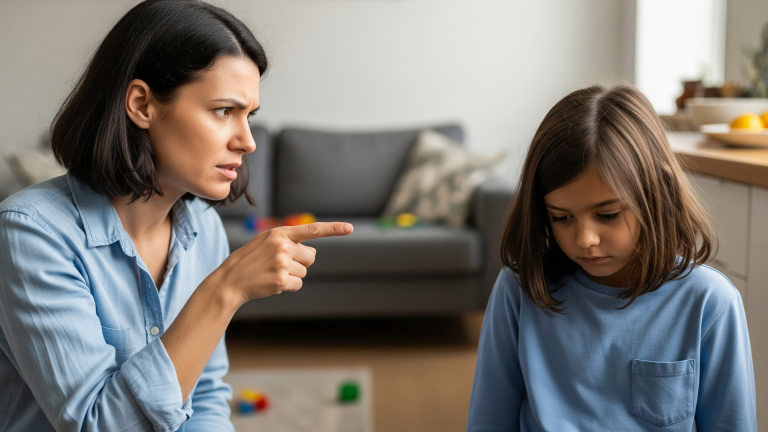Raising Kids in the Digital Age: What Actually Works
Section 1 — Not the Childhood You Had
You didn’t grow up with a smartphone in your hand.
Your childhood probably involved bike rides, cassette tapes, or waiting for your favorite show to come on once a week. Today’s kids? They’ve got YouTube on demand, group chats at age 9, and access to more information (and noise) than most adults can handle.
This isn’t about “good vs. bad.” It’s about different. And fast.
The pace of childhood has changed. The expectations have shifted. And for parents trying to raise kind, curious, emotionally grounded kids — the digital layer adds a whole new level of decision-making.
If you feel unsure, behind, or exhausted from trying to keep up, you’re not alone. And you’re not failing. You’re just parenting in a time that didn’t exist when you were a kid.
Let’s be honest—your childhood didn’t prepare you for this.
There’s no playbook for raising kids with YouTube in their pocket and AI in their homework.
So let’s stop pretending it’s still 1995. Let’s talk about what it actually means to raise kids in the digital age — without the guilt, without the tech panic, and without giving up.
Want to understand what ‘screen time’ really means today — and how much is too much? Start Here
Section 2 — The Real Challenges Modern Moms Are Facing
Let’s be honest: parenting in the digital age isn’t just about “limiting screen time.”
It’s about navigating an entire world your kid can access from the couch.
You’re not just choosing apps and setting timers. You’re:
And most days, you’re doing it with zero clear rules and a million conflicting opinions.
This isn’t about “too much screen time.”
It’s about being the only adult in a room full of invisible tech you didn’t ask for.
You’ve probably asked yourself more than once:
“Is this normal?”
“Is everyone else handling this better than me?”
“How do I even know what’s okay anymore?”
This isn’t a niche problem. It’s the parenting default now.
Because while past generations worried about how much TV their kid watched, today’s parents are managing a full-blown digital ecosystem: smartphones, apps, school tech, social media, YouTube, gaming, AI, and more.
And the kicker? Kids aren’t just using technology. They’re growing up inside it.
Need real structure without power struggles? Start with this guide on digital boundaries that actually stick.
Section 3 — What Kids Actually Need (That Tech Can’t Replace)
Even in a world full of screens, kids still need the same foundational things they always have.
It’s just harder to see that when everything is optimized to grab their attention. So let’s zoom out.
Screens can keep them busy. But they can’t raise them.
That job still belongs to you — even if tech tries to take over.
Here’s what your child really needs to grow — none of which comes built into a tablet:
1. Real Connection
No app or show can replace warm eye contact, laughter, or being truly heard.
Even 10 minutes of undistracted attention from you a day can anchor your child more than hours of background parenting.
Research from Harvard’s Center on the Developing Child shows consistent emotional connection is one of the strongest predictors of resilience in children — even when stress or tech is part of the environment.
2. Structure
Chaos and freedom might sound fun, but kids thrive on knowing what’s next — including when screen time starts and ends.
Clear routines, even loose ones, help kids regulate emotions and behavior. They know what to expect, and that lowers conflict.
Montessori, Waldorf, AAP — nearly every philosophy agrees: Kids need rhythms more than rigid rules.
3. Boredom
Yes, boredom. That quiet space where imagination, creativity, and problem-solving actually kick in.
When screens fill every silence, kids lose the muscle of self-direction.
Letting them get bored (without swooping in to fix it) gives them a chance to develop independence.
4. Hands-On Exploration
Tapping a screen can be fun, but it doesn’t replace the value of building, stacking, drawing, pouring, sorting, and moving.
Fine motor skills, executive function, spatial awareness — these don’t develop from passive watching.
Want screen-free toys that build real skills? Browse our Montessori toy list by age.
5. Emotional Guidance
Kids don’t just need to know how to use tech — they need help managing the feelings that come with it.
Disappointment when the game ends. Frustration when the WiFi crashes. Jealousy from someone else’s perfect life online.
Tech makes emotions bigger. But it’s still up to us to help kids name them, ride them, and recover.
Bottom Line:
Your kid may be growing up with iPads and AI.
But what makes them thrive is still pretty analog: safety, connection, movement, and real-world experience.
Section 4 — How to Parent with Tech (Not Against It)
You don’t need to “beat” technology.
You just need to stay in the driver’s seat.
Here’s how to lead your family with calm, clarity, and confidence — even when the screens are calling:
1. Build Tech Into Your Routine (Not Around It)
Screens should have a place in your day — not run the show.
That means screen time gets scheduled after real-world anchors:
When you treat tech like dessert — not the main course — kids stop expecting it 24/7.
Try building a real-life rhythm that includes — but doesn’t revolve around — tech.
2. Use Tech as a Tool, Not a Babysitter (When Possible)
We all rely on screens sometimes — and that’s fine.
But over time, try to shift the relationship.
Bad tech habit: Tap “play” and walk away.
Better: Watch together, ask questions, follow their interest offline.
Example:
Your kid watches a show about volcanoes? Do the baking soda + vinegar experiment the next day.
Internal link: Montessori and tech can work together — here’s how to make that balance work in real life.
3. Teach Tech Hygiene Early
Start simple:
These “digital manners” become habits. And later? They’re your foundation for bigger rules (like social media use or device limits).
You’re not just raising a tech user. You’re raising someone who knows how to manage their own time, attention, and emotions.
4. Don’t Just Control — Coach
Parental controls are useful. But what matters more is conversation.
Because even the best filter can’t replace judgment.
Talk to your child early and often about:
Remember: Kids don’t need you to be a tech expert. They need you to be their guide.
Teaching kids to self-regulate — with screens or anything else — starts with how we respond to behavior.
Learn how Positive Discipline builds that skill without punishment.
5. Model the Balance You Want to See
Kids don’t do what we say. They do what we see us do.
Want them off devices? Start with your own.
Bottom Line:
You don’t have to fear tech — but you do have to lead.
Screens aren’t raising your child. You are.
With a few steady habits and honest conversations, tech becomes a tool — not a threat.
Section 5 — Real-Life Tech Routines (By Age)
There’s no perfect formula for screen time. But there are patterns that work better.
Let’s break it down by age range — not to give you rules, but to offer clear starting points. These examples help your family move from chaos to clarity, one habit at a time.
Ages 0–2: Build the Foundation — Not the Dependency
What’s realistic:
Focus instead on:
AAP says no solo screen time under 18 months, and limited co-viewed content after that.
Bottom Line: Less screen, more connection. If they’re under 2, your presence is still the best “app.”
Ages 2–5: Keep It Purposeful (and Predictable)
Realistic routine idea:
Examples of smart swaps:
Predictable tech slots help kids know what to expect (and reduce whining).
Internal link: Looking for screen-free alternatives?
Ages 6–9: Add Structure, Not Stress
This age needs:
Sample tech routine:
Example rhythm:
Don’t expect self-control to kick in by itself. They need your rhythm to build their habits.
Ages 10–12: Focus on Balance and Boundaries
They need freedom — with bumpers.
This is when screen time goes from “fun” to social identity. So routines matter more than ever.
Realistic limits:
Sample structure:
Give them more say — but keep the boundaries. Ask, “What’s your screen plan for today?” and tweak it together.
Thinking about giving them their first phone? Here’s how to know if they’re really ready—and what to do before saying yes.
Ages 13+: Teens Need Tech — and Accountability
By now, screen time isn’t a “treat.” It’s how your teen socializes, relaxes, learns, escapes, and even expresses who they are. That doesn’t mean you hand over the phone and walk away.
This stage is all about trust with guardrails — and lots of real conversations.
What teens actually need:
Realistic screen rhythm:
Ask instead of assume:
Build in these anchor points:
“Tech freedom without reflection is just escape.” Help them notice how screen use makes them feel — and adjust accordingly.
Recap:
Perfection is a trap.
Presence is what changes the game.
You don’t need a perfect system. You need a pattern that works for your kid and your life.
Start small. Use screen time to support what your child already loves — not to fill every quiet moment.
Section 6 — The Role of the Parent Hasn’t Changed — Just the Tools
You are still the most important tech filter your child has.
Not an app.
Not the Wi-Fi router.
Not parental control software.
You.
Even in a digital world, kids still need the same things they always have:
Screens don’t cancel that out. They just change where and how parenting shows up.
5 Roles Parents Still Play — Even in a Tech-Heavy World:
1. You’re the Gatekeeper
You control the access. When they get a device, what’s on it, what the house rules are. Don’t hand that power away to an algorithm.
2. You’re the Mirror
Kids watch how you use tech. If you can’t unplug, they won’t either. Model boredom. Model boundaries. Model being present.
3. You’re the Coach
You don’t just say “no.” You explain why. You troubleshoot. You help them reflect. You teach them how to bounce back from mistakes.
4. You’re the Safe Zone
They’ll mess up. They’ll hide stuff. But your reaction determines whether they’ll come to you next time. Be curious before critical.
5. You’re Still the Boss
Even with older kids, it’s okay (and necessary) to say “This isn’t working for our family. Let’s try something different.”
Real Talk: You Don’t Have to Be a Tech Expert
You just have to show up. Ask good questions. And keep showing up even when they eye-roll you out of the room.
That is digital parenting.
Section 6 — Raising Digital Kids Isn’t About Perfection — It’s About Being Present
You’re not raising your kids despite the digital world.
You’re raising them within it.
What we covered:
So what now?
Try this:
Small shifts make big change.
You don’t need to do it perfectly.
You just need to keep showing up.
Because raising kids in the digital age isn’t about escaping screens altogether.
It’s about raising thoughtful, resilient, grounded humans in spite of them.
You’ve already started.
Now keep going. That’s the real win.
Save it. Share it. Send it.
Found this helpful? Save this article for when screen time starts feeling out of control again.
Share it with your partner, your mom group, or that friend who just handed their kid an iPad and whispered “I give up.”
Because raising kids in the digital age doesn’t have to mean losing your grip — or your sanity.








